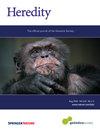Environmentally induced variation in sperm sRNAs is linked to gene expression and transposable elements in zebrafish offspring
IF 3.9
2区 生物学
Q2 ECOLOGY
引用次数: 0
Abstract
Environmental factors affect not only paternal condition but may translate into the following generations where sperm-mediated small RNAs (sRNAs) can contribute to the transmission of paternal effects. sRNAs play a key role in the male germ line in genome maintenance and repair, and particularly in response to environmental stress and the resulting increase in transposable element (TE) activity. Here, we investigated how the social environment (high competition, low competition) of male zebrafish Danio rerio affects sRNAs in sperm and how these are linked to gene expression and TE activity in their offspring. In a first experiment, we collected sperm samples after exposing males to each social environment for 2 weeks to test for differentially expressed sperm micro- (miRNA) and piwi-interacting RNAs (piRNA). In a separate experiment, we performed in vitro fertilisations after one 2-week period using a split-clutch design to control for maternal effects and collected embryos at 24 h to test for differentially expressed genes and TEs. We developed new computational prediction tools to link sperm sRNAs with differentially expressed TEs and genes in the embryos. Our results support the idea that the molecular stress response in the male germ line has significant down-stream effects on the molecular pathways, and we provide a direct link between sRNAs, TEs and gene expression.

环境诱导的精子sRNAs变异与斑马鱼后代的基因表达和转座因子有关。
环境因素不仅影响父亲的状况,而且可能转化为后代,其中精子介导的小rna (sRNAs)可以促进父系效应的传播。sRNAs在雄性生殖系基因组的维持和修复中起着关键作用,特别是在对环境胁迫的反应和由此引起的转座因子(TE)活性的增加中。在这里,我们研究了雄性斑马鱼的社会环境(高竞争和低竞争)如何影响精子中的sRNAs,以及这些sRNAs如何与后代的基因表达和TE活性相关联。在第一个实验中,我们将雄性暴露于每种社会环境2周后收集精子样本,以检测精子微rna (miRNA)和piwi相互作用rna (piRNA)的差异表达。在另一项单独的实验中,我们在2周后使用分离离合器设计进行体外受精以控制母体效应,并在24小时收集胚胎以检测差异表达基因和TEs。我们开发了新的计算预测工具,将精子sRNAs与胚胎中差异表达的TEs和基因联系起来。我们的研究结果支持了雄性生殖系分子应激反应对分子通路有显著下游影响的观点,我们提供了sRNAs、TEs和基因表达之间的直接联系。
本文章由计算机程序翻译,如有差异,请以英文原文为准。
求助全文
约1分钟内获得全文
求助全文
来源期刊

Heredity
生物-进化生物学
CiteScore
7.50
自引率
2.60%
发文量
84
审稿时长
4-8 weeks
期刊介绍:
Heredity is the official journal of the Genetics Society. It covers a broad range of topics within the field of genetics and therefore papers must address conceptual or applied issues of interest to the journal''s wide readership
 求助内容:
求助内容: 应助结果提醒方式:
应助结果提醒方式:


